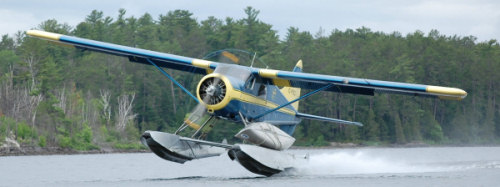Hi Larry...

At an aerodrome with several hard or grass runways and water designated runways there will be information published in the Transport Canada Water Aerodrome Supplement which lists all the Water Aerodromes in Canada.
Aerodromes without published water landing strips but are next to water and are frequented by seaplanes and floatplanes will also have some information published in the Canada Flight Supplement which is published quarterly along with information published in the Transport Canada Water Aerodrome Supplement published once a year normally.
These are not free publications and must be subscribed to and I do believe some Aviation Stores do carry them.
Here in Canada I believe they are published by NAV CANADA.
I am also sure that the United States of America Federal Aviation Authority must publish or have published these same books.
I am very sure we have seen them.
They are also used by members of both countries militarys and I am sure visiting military units from elsewhere.
The Water Circuit is usually set up to keep the seaplane or float plane away from land and conflicting hard or grass runways used by wheeled/skid aircraft.
Wheeled or skid aircraft tend to be faster than most float planes and such as small bugsmashers like the cub etc.
This helps to keep the circuit moving smoothly.
In case of an engine failure with the float plane the aviator has a much better chance to make a safe landing.
Now of course an amphibious aircraft such as the DeHavilland Otter could use both circuits without a problem to traffic in either case.
Now a float plane aviator or any aviator flying off water who have not purchased either the Water Aerodrome Supplement or the Canada Flight Supplement only has to look at a VFR Map for information or use his radio to ask the aerodrome he is landing at for instructions.
A lot of pilots seem to have a problem asking for help or saying on the radio they are unfamiliar with the area and aerodrome.
Believe me, a good tower controller will be glad to assist an aviator on landing either on the water or the aerodrome and I have never seen/heard one complain yet if you call them ten miles out and not overhead the aerodrome for information.
Now let us say you are going to land at a Lodge, fishing or hunting, does not matter.
You have your trusty Cessna 172 on floats but the Lodge is not in the Canada Water Aerodrome Supplement or on the map...egads...stay home...

Just kidding...

First overfly the lodge like you would a normal airport and check the wind and water conditions...
Announce your position and intentions on the Unicom Frequency that is most likely to be used...
If you have filed a Flight Plan or Flight Notification this would be a good time to cancel it with whatever Station/Unit you filed it with...

Do not leave it open or forget it as they will send Search and Rescue for you...can be expensive...

If the Lodge has a radio frequency...call them several miles out...most will not...
Set yourself up for a water landing and annouce your intentions prior to landing...remember to keep flying the aircraft...
Okay...now you have landed...the trusty old Cessna 172 is tied to the dock...you do remember your Boy Scout and Girl Guide Knots right?
Step onto the dock...run into the woods...kiss the first bear you see because you have made it...

Have a great day Larry...























 8-)
8-)


